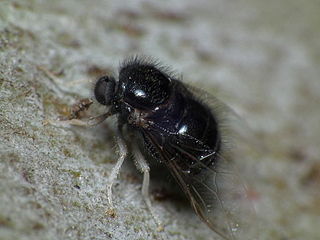
Flies are insects of the order Diptera, the name being derived from the Greek δι- di- "two", and πτερόν pteron "wing". Insects of this order use only a single pair of wings to fly, the hindwings having evolved into advanced mechanosensory organs known as halteres, which act as high-speed sensors of rotational movement and allow dipterans to perform advanced aerobatics. Diptera is a large order containing an estimated 1,000,000 species including horse-flies, crane flies, hoverflies and others, although only about 125,000 species have been described.

Hover flies, also called flower flies or syrphid flies, make up the insect family Syrphidae. As their common name suggests, they are often seen hovering or nectaring at flowers; the adults of many species feed mainly on nectar and pollen, while the larvae (maggots) eat a wide range of foods. In some species, the larvae are saprotrophs, eating decaying plant and animal matter in the soil or in ponds and streams. In other species, the larvae are insectivores and prey on aphids, thrips, and other plant-sucking insects.

The Bombyliidae are a family of flies, commonly known as bee flies. Adults generally feed on nectar and pollen, some being important pollinators. Larvae are mostly parasitoids of other insects.

Anthrax is a genus of bombyliid flies, commonly known as "bee-flies" due to their resemblance to bees. Most are dull black flies, and are usually small to medium in size, 4–20 millimetres (0.2–0.8 in), and many species have striking wing patterns.

The Asiloidea comprise a very large superfamily insects in the order Diptera, the true flies. It has a cosmopolitan distribution, occurring worldwide. It includes the family Bombyliidae, the bee flies, which are parasitoids, and the Asilidae, the robber flies, which are predators of other insects.

The Acroceridae are a small family of odd-looking flies. They have a hump-backed appearance with a strikingly small head, generally with a long proboscis for accessing nectar. They are rare and not widely known. The most frequently applied common names are small-headed flies or hunch-back flies. Many are bee or wasp mimics. Because they are parasitoids of spiders, they also are sometimes known as spider flies.

Bombylius major is a parasitic bee mimic fly. B. major is the most common type of fly within the Bombylius genus. The fly derives its name from its close resemblance to bumblebees and are often mistaken for them.

Hemipenthes is a large genus of flies belonging to the family Bombyliidae (bee-flies). There are many described species, distributed throughout the Holarctic realm. These are small to large robust flies with a body length of 5–14 mm. They can be distinguished from similar genera (Villa) by their wing venation. A number of species formerly in this genus were moved to a separate genus, ins in 2020.

Hemipenthes morio is a species of 'bee flies' belonging to the family Bombyliidae subfamily Anthracinae.
Diptera is an order of winged insects commonly known as flies. Diptera, which are one of the most successful groups of organisms on Earth, are very diverse biologically. None are truly marine but they occupy virtually every terrestrial niche. Many have co-evolved in association with plants and animals. The Diptera are a very significant group in the decomposition and degeneration of plant and animal matter, are instrumental in the breakdown and release of nutrients back into the soil, and whose larvae supplement the diet of higher agrarian organisms. They are also an important component in food chains.

Hyperalonia is a genus of bee flies in the family Bombyliidae.

Bombylius canescens, is a species of bee-fly belonging to the family Bombyliidae.

Anthracinae is a subfamily of bee flies in the family Bombyliidae. There are more than 80 genera and 2,000 described species in Anthracinae.

Exoprosopini is a tribe of bee flies in the family Bombyliidae. There are more than 20 genera and 760 described species in Exoprosopini.

Lordotus pulchrissimus is a species of bee fly in the taxonomic order Diptera and family Bombyliidae. It is also frequently referred to as the desert bee fly. Few studies have been done on the biology of L. pulchrissimus, although their behavior in the wild has been observed.

Phthiriinae is a subfamily of bee flies in the family Bombyliidae. There are about 11 genera and more than 120 described species in Phthiriinae.
Systoechus vulgaris, the grasshopper bee fly, is a species of bee fly in the family Bombyliidae. Its larvae are predators of grasshopper eggs.

Xenox is a genus of bee flies. There are five described species in Xenox, all of which parasitize bees in the genus Xylocopa as larvae.
Astrophanes adonis is a species of bee flies.

Hemipenthes maura is a species of bee fly belonging to the family Bombyliidae.

















